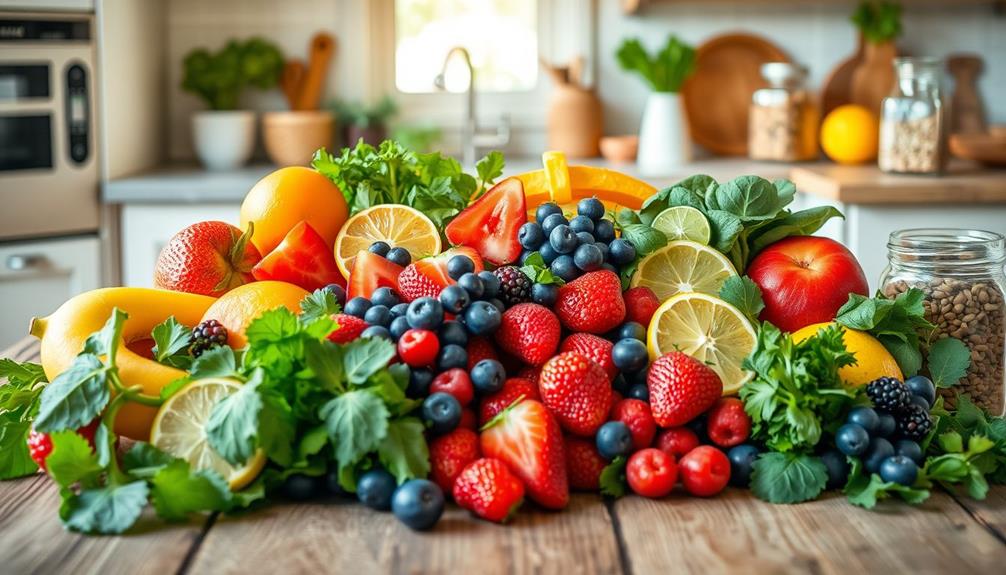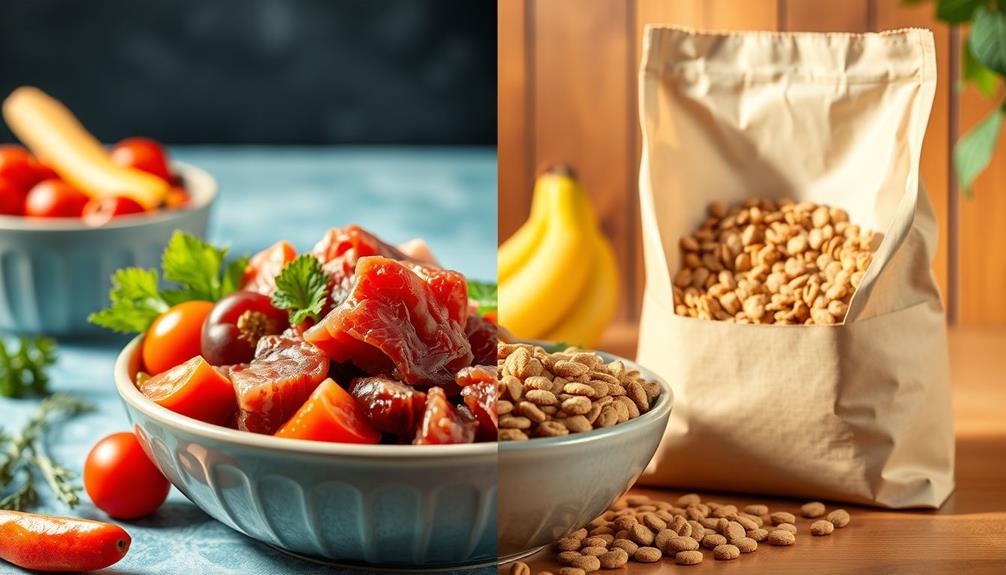The raw food diet emphasizes eating uncooked and unprocessed foods, such as fruits, vegetables, nuts, and seeds. You'll want to keep food temperatures below 104-118°F to preserve nutrients and enzymes. Many people adopt this diet for its potential health benefits, like increased energy and weight loss, as it encourages a higher intake of fresh produce. However, be cautious of possible nutritional deficiencies, particularly in vitamin B12 and protein. It's essential to learn proper preparation methods and seasonal ingredients to thrive on this diet. Stick around if you want to uncover more insights and tips!
Key Takeaways
- The raw food diet emphasizes uncooked and unprocessed foods, including fruits, vegetables, nuts, seeds, and sprouted grains, to preserve nutrients.
- Followers maintain food temperatures below 104-118°F (40-48°C) to retain enzymes and essential components believed to enhance health.
- Health benefits include lower risks of chronic diseases, increased energy, and potential weight loss; however, nutritional deficiencies are a concern.
- Common deficiencies include vitamin B12, calcium, omega-3 fatty acids, and protein, necessitating careful meal planning and possible supplementation.
- Preparation methods include juicing, blending, dehydrating, soaking, and sprouting, with an emphasis on organic and seasonal produce for optimal nutrition.
Overview of the Raw Food Diet
The raw food diet emphasizes eating uncooked and unprocessed foods, primarily fruits, vegetables, nuts, seeds, and sprouted grains. This approach keeps the temperature of food below 104-118°F (40-48°C), ensuring that you preserve the nutrient content and natural enzymes essential for peak health. Advocates believe that cooking destroys these crucial components, which can lead to various health benefits.
Additionally, consuming fresh foods like celery juice can complement this diet by providing high levels of antioxidants and promoting hydration.
When you adopt the raw food diet, you often increase your intake of fresh fruits and vegetables, which may enhance your energy levels and promote weight loss. By focusing on whole, unprocessed foods, you're likely to avoid refined, tinned, and pasteurized items that can diminish your nutrient intake.
Many people who follow this diet report improved digestion and a feeling of vitality that comes from consuming such fresh ingredients.
Historically, this dietary practice dates back to the mid-19th century, initiated by Oskar Bircher-Benner, who recognized the health benefits associated with raw food consumption.
Whether you choose to go fully raw or incorporate more uncooked foods into your meals, this diet can greatly impact your overall well-being.
Allowed Foods and Preparation Methods
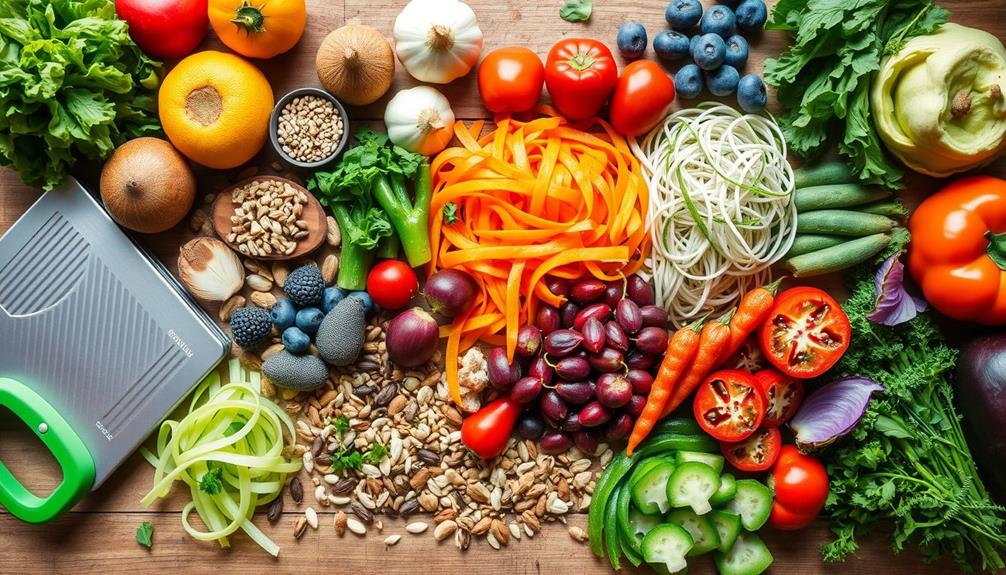
A variety of uncooked foods forms the foundation of the raw food diet, allowing you to enjoy a rich selection of fruits, vegetables, nuts, seeds, and sprouted grains. Additionally, many raw food enthusiasts also incorporate fermented foods such as sauerkraut, kimchi, and kombucha into their diet to promote healthy gut bacteria. The raw food diet is known for its emphasis on consuming food in its natural state, without cooking or processing, in order to preserve the maximum amount of nutrients and enzymes. Some people choose to adopt a raw food diet for health reasons, believing that it can lead to increased energy, improved digestion, and weight loss.
The emphasis on organic, uncooked foods encourages you to choose fresh, seasonal produce to maximize nutrient content and flavor while minimizing pesticide exposure. Additionally, incorporating health-promoting elements like essential oils for wellness can further enhance your overall well-being.
Here are some allowed foods:
- Uncooked fruits: Apples, bananas, berries
- Vegetables: Leafy greens, carrots, cucumbers
- Nuts: Almonds, walnuts, cashews
- Seeds: Chia, flaxseed, sunflower
- Sprouted grains: Quinoa, brown rice, buckwheat
Preparation methods are essential in the raw food diet to enhance digestibility and nutrient availability.
You can enjoy your foods through:
- Juicing
- Blending
- Dehydrating
- Soaking
- Sprouting
It's important to note that processed, refined, and heated items above 104-118°F (40-48°C) are excluded.
Some followers may include unpasteurized dairy, raw eggs, or raw meats, depending on personal preferences.
Health Benefits and Risks
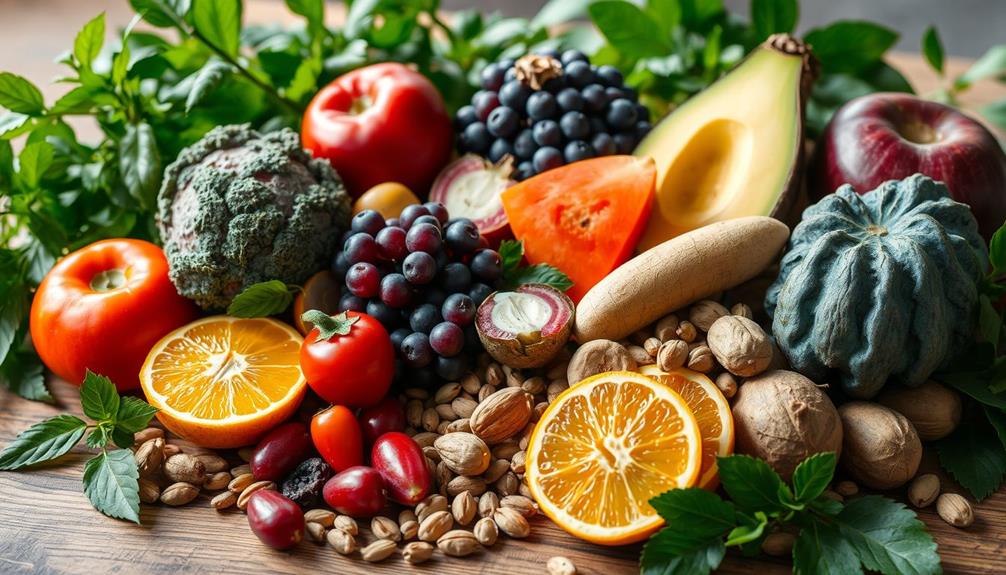
Embracing the raw food diet can offer numerous health benefits, largely due to the increased intake of fruits and vegetables. This diet's high fiber and antioxidant content can lower your risk of chronic diseases, like heart disease and diabetes.
Additionally, incorporating foods that have been shown to support overall health, such as those in a gout-friendly diet, may enhance your experience. You might also notice a lower body mass index (BMI), which many find appealing.
However, along with these benefits come significant risks that you should consider. One major concern is the potential for nutritional deficiencies, particularly in essential nutrients like vitamin B12, iron, and protein. If you don't carefully plan your meals, these deficiencies can impact your overall health.
Additionally, while raw foods retain water-soluble vitamins, cooking can enhance the bioavailability of certain nutrients, suggesting that a balanced diet may be more advantageous.
Moreover, the consumption of raw foods can increase your risk of foodborne illness, especially from raw meat, eggs, and unwashed produce. Prioritizing food safety practices is vital to minimize this risk.
Nutritional Considerations and Deficiencies
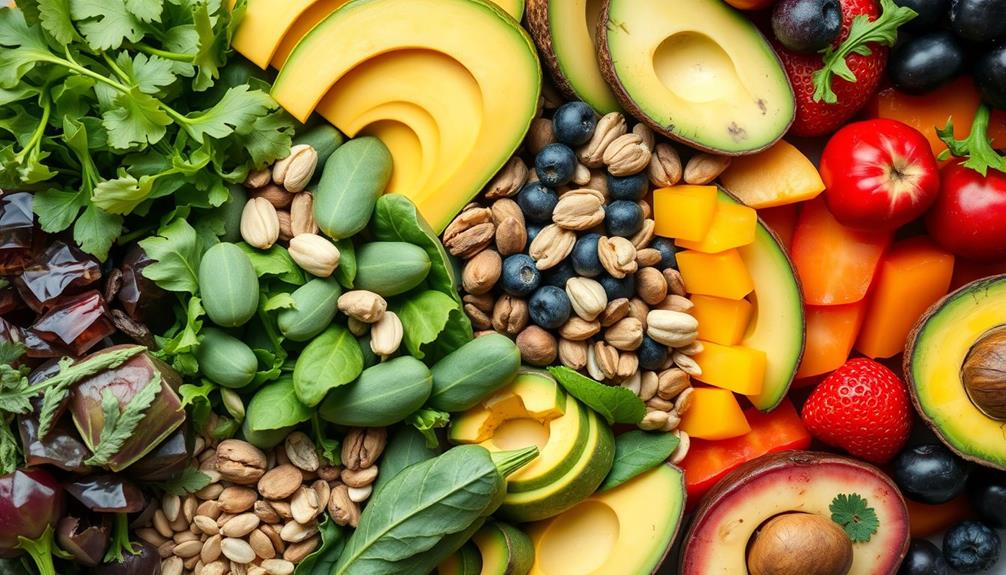
While following a raw food diet can be appealing for its health benefits, it's important to take into account potential nutritional deficiencies that may arise. Many individuals on this diet might miss out on essential nutrients due to the exclusion of animal products and limited food variety.
Understanding common financial terms can also be advantageous when budgeting for specialty foods that meet raw dietary needs. Here are some common concerns:
- Vitamin B12: Often lacking, this vitamin is primarily found in animal products, and its deficiency can lead to serious health issues.
- Calcium: Important for bone health, inadequate intake may contribute to lower bone mass over time.
- Omega-3 Fatty Acids: Crucial for heart and brain health, these are often low in a raw food diet.
- Protein Intake: Achieving adequate protein can be challenging without careful planning since many raw sources are low in protein.
- Bioavailability: Cooking can enhance the bioavailability of certain nutrients, which may not be as accessible in raw foods.
Long-term followers of a raw vegan diet should consider supplementation to guarantee a balanced nutrient profile and guard against potential deficiencies.
Being aware of these factors will help you maintain a healthy and sustainable raw food lifestyle.
Practical Tips for Beginners
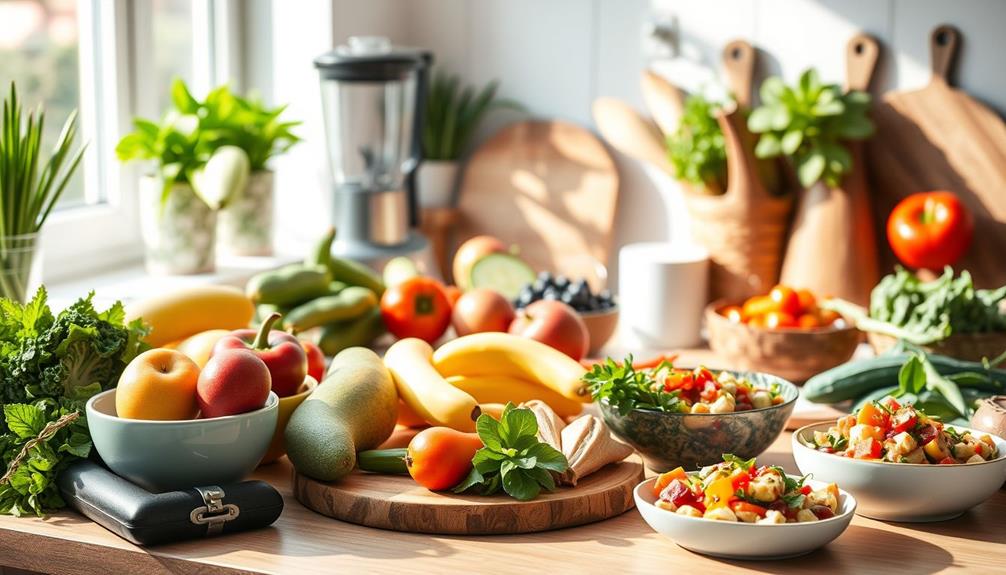
Shifting to a raw food diet can be an exciting journey filled with discovery and creativity. Start by gradually incorporating more raw foods into your meals, aiming for a blend of fruits, vegetables, nuts, and seeds. This approach eases the change while maintaining variety in your diet.
Invest in kitchen appliances like a high-quality blender and food processor to simplify meal preparation and inspire creative recipe experimentation. Additionally, consider the benefits of raw food that enhance nutrient absorption and boost your immune system.
Focus on seasonal and locally sourced produce to maximize both flavor and nutritional value. Planning your meals ahead of time helps guarantee a balanced intake of nutrients, which is vital for maintaining adequate protein intake and avoiding deficiencies in vitamins B12 and D.
Don't go it alone; join online communities or local groups dedicated to raw food diets. These platforms offer invaluable support, recipe sharing, and motivation to keep you inspired.
Research and Evidence Insights
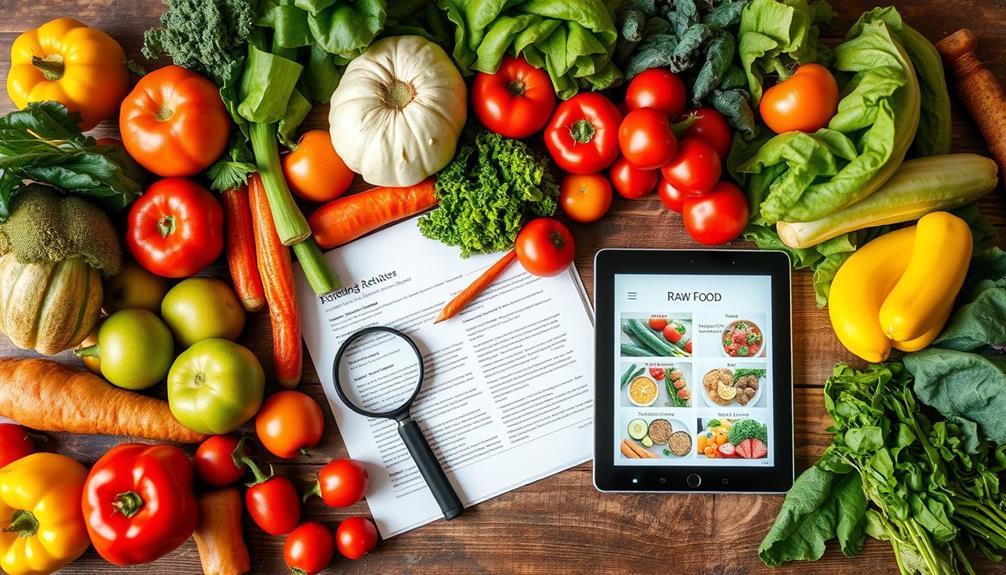
Research consistently reveals intriguing insights about the raw food diet and its effects on health. While some studies indicate that individuals following this diet may enjoy benefits like weight management and lower cholesterol levels, there are significant concerns regarding nutrient deficiencies.
Individuals with certain mental health conditions, such as Borderline Personality Disorder (BPD), may experience heightened emotional responses that could be influenced by dietary choices.
Here's what research has uncovered:
- Raw food dieters often have a lower body mass index (BMI) compared to those on omnivorous diets.
- Higher intake of fruits and vegetables is common, but this can lead to deficiencies in essential nutrients like vitamin B12, iron, and protein.
- Cooking methods can enhance the bioavailability of certain nutrients, challenging the superiority of raw foods.
- Some studies report reduced cholesterol and triglycerides in raw food dieters, but they also show elevated homocysteine levels, which can increase cardiovascular risks.
- Risks like lower bone mass and menstrual cycle disruptions may arise from inadequate nutrient intake.
Frequently Asked Questions
What Can't You Eat on a Raw Food Diet?
You can't eat any cooked foods, processed snacks, or animal products unless they're raw. Avoid preservatives, canned items, and certain raw foods like kidney beans, sprouts, and green potatoes due to health risks.
What Do Doctors Say About the Raw Food Diet?
Doctors often caution you about the raw food diet like a double-edged sword. While it can boost fruit and vegetable intake, it may lead to nutrient deficiencies and health risks if not properly planned.
What Are the Principles of a Raw Food Diet?
The principles of a raw food diet focus on eating uncooked, unprocessed foods, like fruits and vegetables. You'll prioritize nutrient preservation, using methods like soaking and sprouting to enhance nutrition while avoiding high-temperature cooking.
What Is Raw Food Explanation?
You think eating raw food means munching on lettuce and carrots, right? Actually, it's about savoring uncooked fruits, veggies, and nuts. It's a fresh, vibrant lifestyle that might just surprise your taste buds!
Conclusion
To sum up, the raw food diet can be an invigorating approach to eating, promoting whole, unprocessed foods. Did you know that studies suggest raw food enthusiasts can consume up to 50% more antioxidants than those who eat a standard diet? While there are numerous health benefits, it is crucial to be mindful of potential nutritional deficiencies. If you're considering this lifestyle, start slowly, experiment with recipes, and listen to your body for the best experience.

